This post has been informed by comments made on my series of six posts on “Will the repairs to the funicular work” and discussion with people with a far greater knowledge of construction and civil engineering than me.
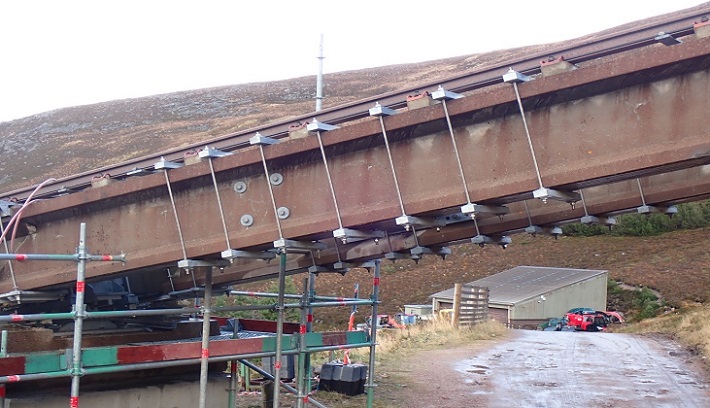
When I commented on this picture in my second post on the funicular court cases (see here) I had not realised that there are two different types of brackets holding the beams together. The second type can just be seen at the very edge of the left hand side, but, is better seen in this picture of pier 60 which appeared on social media last Saturday:-
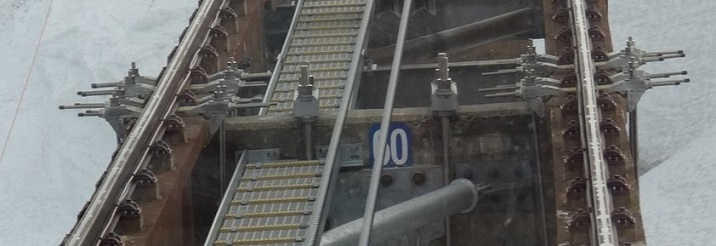
The four outer brackets which are clamping the insitu blocks to the “I” beams are more complex than the two inner brackets around the insitu block. This indicates that there is a major problem at those joints, something that I have suggested and commented on before (see here) and (here), including the following screenshot which shows the “I” beams and in-situ joints:-
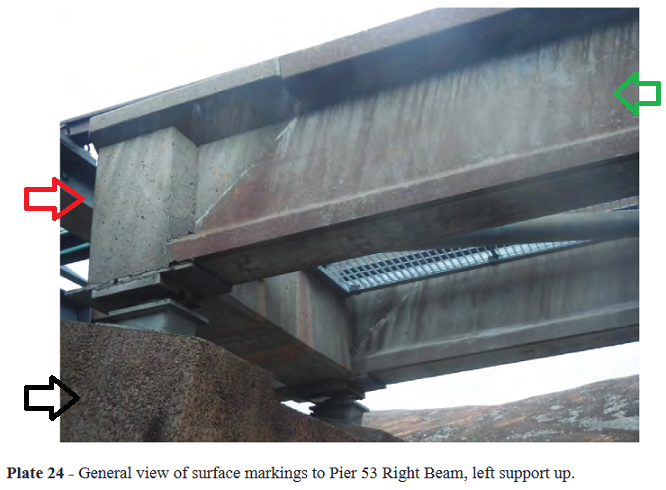
Apart from showing us exactly what the brackets look like, four other things immediately stand out from the photo with the brackets.
(1) The maintenance walkway.
This was missing from much of the funicular (see photo from the Funimag below) but was in place at others (eg Pier 53 in photo above). Its removal was reported to the Health and Safety Executive and it appears thanks to their intervention a walkway has now been put in place to ensure the safety of CM(S)L inspection/ maintenance crew working on the structure.
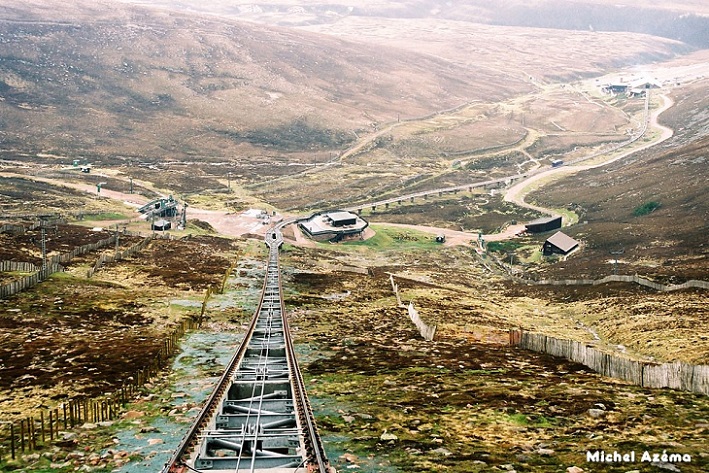
The absence of large sections of the walkway was a point made several times by ADAC Structures in previous reports into the funicular. It should make the annual inspection by ADAC Structures easier, more comprehensive and therefore more accurate.
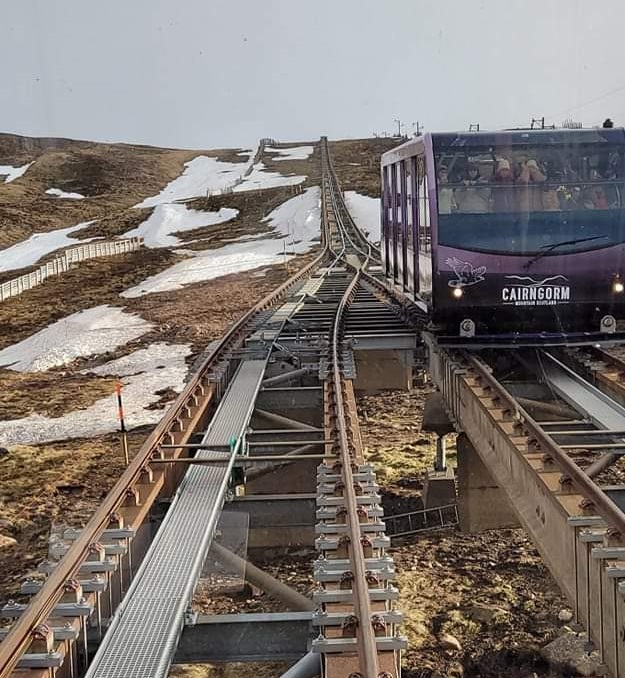
As far as I can tell this is a completely new walkway, which begs the question if it is, “What happened to the previous steel walkway sections of which were left lying on the ground for years”? Who got the scrap money for that? Another charity?!
(2) The protruding steel-work.
In my opinion there is now a new safety risk for inspectors and people working by the funicular which also shows poor work practices and that is the length of studding/ threaded bar, holding the brackets together, protruding from (a) the sides and (b) up into the air.
(a) The excess steel-work protruding outwards from the brackets will hinder staff clearing snow away from the track and could cause injury, and,
(b) The extra lengths especially in the middle of the walkway, are a tripping hazard for staff working on it, from which someone could be seriously injured or even worse!
Why were the excess lengths not removed to make the work more presentable and safer?
Where are the safety markers that should be placed near those brackets? Even a coat of red paint would make them more obvious!
(3) The state of the rails.
This is easier to see from another photo taken from the same social media page showing the right hand track as it leaves the base station:-
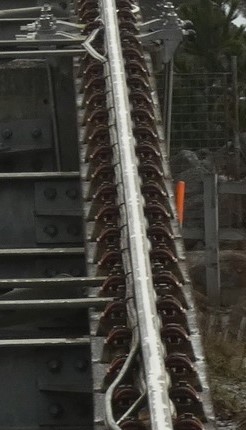
The photo shows that the track did not have a surface grind before rail operations recommenced. The shiny mid- section is where the bogie wheels are touching the centre of the rail with lateral shiny bits where the wheels touch now and again. These are high spots on the rails known in the rail world as “corrugations” and are a major cause of vibration which damages the concrete structure of the system (see here for my fuller explanation of the importance of grinding and the impact of vibration).
After FOUR years of inactivity and the track rusting a rail grind was one of those jobs that should have been a major part of the repair/ strengthening works and shows how both CM(S)L and HIE have a lackadaisical approach to health and safety. Nothing appears to have changed since the COWI report in 2018 (page 311) stated:
“Poor workmanship appears to have been consistent throughout the build and subsequent maintenance”
(4) The work is different to what was shown in the planning application
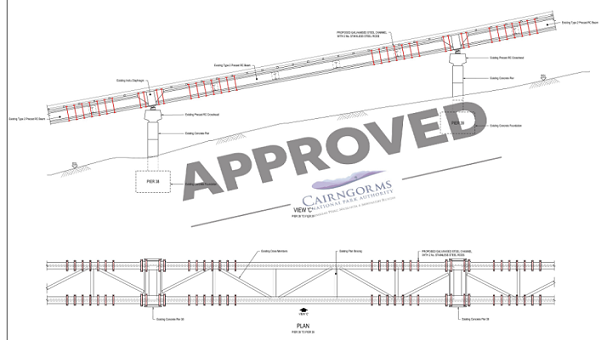
Note that the two brackets on the insitu blocks are not shown! A later addition?
After my post on the court cases (link above) I had a phone conversation with a concrete specialist who had worked on the funicular build, amongst other projects on the hill and had posted this on social media:

Resin injection is apparently an industry standard response to cracking in concrete structures
Appendix A to the report issued by ADAC Structures in November 2015 (obtain by FOI but no longer on HIE’s website) lists the problems that existed but did not explicitly recommend a shut down until repairs were initiated. Some of those repairs were however classified as Immediate Repair or Repair Priority.

The list goes on and up to the tunnel:
 7
7
Are these the faults that should have triggered an immediate shutdown? Was the structural engineer told not to mention a shutdown in the report or is it implicit in “immediate repair”?.
Several FOI requests have now been submitted about the repairs/ strengthening and for paperwork relating to the re-opening of the funicular which, when made available, will no doubt raise even more questions including the sense of repairing the funicular rather than demolishing it.
Watch this space.
Graham, given the potential health and safety hazards highlighted in your article it beggars belief how the DoT and the Office of Rail & Road could certify the funicular as safe to return to use. Political expediency?
This is the reply I received to an FOI request
I refer to your email of 1st February regarding the Cairn Gorm Funicular Railway.
Your request has not been treated as a Freedom of Information request as this type of railway is not within the jurisdiction of the Office of Rail And Road (ORR). You should forward your request to the Health and Safety Executive (HSE), a list of their offices can be found here: https://www.hse.gov.uk/contact/maps/
I’m waiting now to see what the DfT have to say, then on to the HSE. I didn’t know the HSE have rail inspectors!
Hello Graham… thank you for using one of my 2002 photos with credit.
On all modern funiculars there are walkway/stairs all along one side of the track! Of course this is easier to maintain the track with such a lateral walkway but there is also another very important reason… this is for security reason! In case the cars of the funicular are blocked in the middle of the track with many passengers inside (some may also be disabled) it will be necessary to evacuate the passengers and this is the main reason most of funiculars have such lateral walkway/stairs.
What I saw is that there is some kind of walkway inside the track (between the rails). True? I am not sure it will be easy to evacuate passengers with such a walkway.
Look at the lateral walkway on the Stoosbahn, the World steepest funicular:
https://upload.wikimedia.org/wikipedia/commons/0/07/Stoos_Standseilbahn.jpg
Why a lateral walkway was not imposed to Cairngorm Mountain funicular by authorities?
Michel Azéma (Funimag.com)
Michel. I tried once before to get something done about the walkway which is not even shown in your photo but was told by HSE as I could not prove its non-existence they could not pursue it! The structural engineer who reported on it being missing was also ignored by CML. At least there is some kind of walkway in place now, but as I’ve said Watch This Space!
Graham, Concerning walkway at Cairngorm funicular I reviewed my 2002’s photos and I confirm there was no walkway between the rails all along the track… except at the beginning of the track at the lower station!
See my 2002’s photos:
You see the walkway starting from the lower station and ending just beside the vertical wooden stick:
https://www.funimag.com/funimag22/263-img003.jpg
But just after the vertical stick there is no more walkway!
https://www.funimag.com/funimag22/263-img002.jpg
Strange isn’t it?
Michel
The walkway, as far as anyone is aware, was never completely installed. There are numerous videos on Youtube which were presented as evidence but the Health & Safety people would not accept that. One video in particular covers the full length of the track. HSE may have been told to mind their own business! There were also piles of it lying in various places.